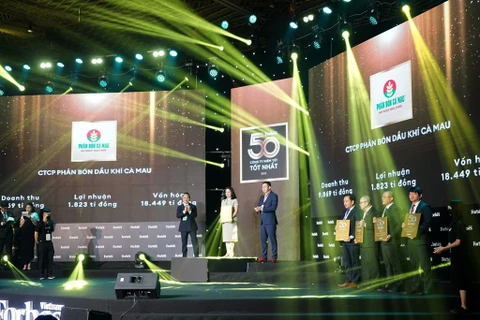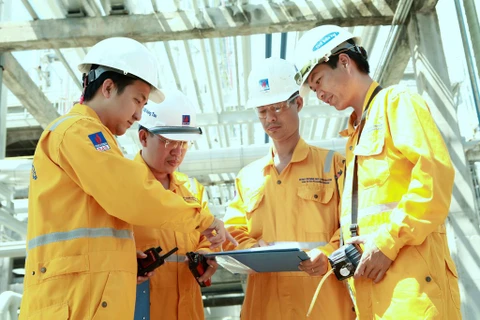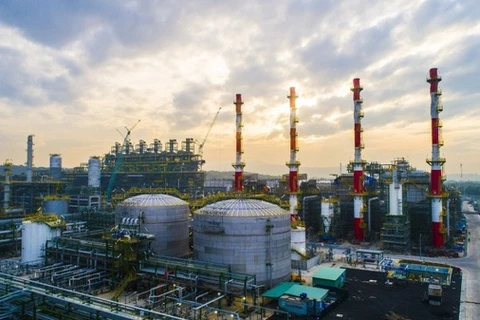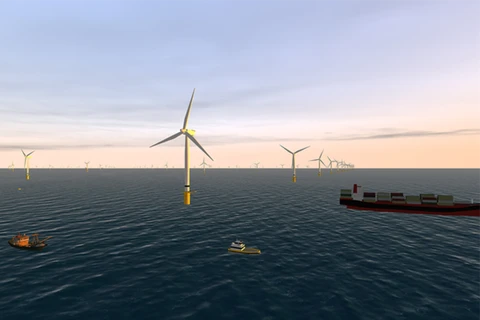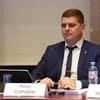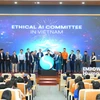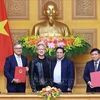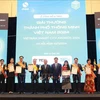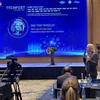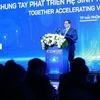Hanoi (VNA) – The Vietnam Petroleum Institute (VPI), a member of the Vietnam Oil and Gas Group (PetroVietnam), has applied artificial intelligence (AI) and machine learning to quickly identify the presence of fractured granite basement, with an accuracy rate of over 80%, helping save exploration time and costs.
The discovery and successful exploitation of fractured granite basement reservoirs at Bach Ho (White Tiger) and other oil fields in Vietnam have changed the traditional oil and gas exploration viewpoint and contributed to the formation of a new one in the region and the world.
However, the identification of fractured granite basement by using traditional methods needs specialised equipment that may require suspension of oil well drilling, lengthen the rig rental duration (the current rental is about 65,000 - 68,000 USD per day), and raise expenses.
To optimise this process, the VPI has worked out a fracture prediction solution that applies artificial intelligence and machine learning, helping to accurately detect the presence of fracture systems basing on real-time data.
Relevant data will be used as inputs into machine learning algorithms, and then models will be classified, ranked, and assessed to find out the best for fracture prediction.
The VPI has tested the accuracy of this prediction model on drilling data of 12 wells in some fields with similar geological structures, showing a prediction accuracy rate of more than 80%.
Results are given on the machine learning operations (MLOps) platform, expected to help improve drilling effectiveness, ensure safety for the process, and shorten the rig rental duration. Depending on each contractor’s drilling plan, the saved expenses can reach hundreds of thousands of US dollars.
Le Ngoc Anh, Data Director of the VPI, said the fracture prediction model makes use of the oil and gas sector’s existing data to develop optimisation algorithms to create new values and guarantee security and safety.
The application of machine learning and artificial intelligence to oil and gas exploration is the next milestone in the implementation of PetroVietnam’s digital transformation strategy so as to promote the business model switching, optimise operations, and improve governance capacity.
In early July, the VPI succeeded in building Oilgas AI, an ecosystem using artificial intelligence and machine learning to gather, demonstrate, and analyse specialised data about such products as crude oil, petrol, liquefied petroleum gas, and natural gas to offer solutions helping businesses make quicker and more effective decisions during their daily operations, as well as build long-term plans and strategies.
PetroVietnam has been developing and perfecting appropriate and effective solutions, while coordinating with socio-political organisations in promoting digital transformation at its subsidiaries.
In a resolution on digital transformation to 2025, with a vision to 2030, issued in February this year, PetroVietnam viewed digital transformation as a must to increase productivity, quality, efficiency, and competitiveness.
Digital transformation is seen as a strategic task of PetroVietnam, and is especially important for the group’s businesses and units.
The work is hoped to help the firm promote innovation and improve business performance and competitiveness, as well as its leading position in the oil and gas industry, thus contributing to the country’s digital economy.
During the first half of 2022, PetroVietnam pumped out 5.48 million tonnes of crude oil, surpassing the H1 target by 23%.
Meanwhile, gasoline production exceeded the plan by 14%, and fertiliser production surpassed the target by 8%. Production and supply of gas, electricity and other energy products also reached a high level.
The H1 revenue was estimated at 468.3 trillion VND (20 billion USD), up 55% year-on-year and double the goal set for six months. The group contributed 66.1 trillion VND to the State budget, 2.2 times higher than the half-year plan and rising 41% from the same period last year, statistics showed./.
The discovery and successful exploitation of fractured granite basement reservoirs at Bach Ho (White Tiger) and other oil fields in Vietnam have changed the traditional oil and gas exploration viewpoint and contributed to the formation of a new one in the region and the world.
However, the identification of fractured granite basement by using traditional methods needs specialised equipment that may require suspension of oil well drilling, lengthen the rig rental duration (the current rental is about 65,000 - 68,000 USD per day), and raise expenses.
To optimise this process, the VPI has worked out a fracture prediction solution that applies artificial intelligence and machine learning, helping to accurately detect the presence of fracture systems basing on real-time data.
Relevant data will be used as inputs into machine learning algorithms, and then models will be classified, ranked, and assessed to find out the best for fracture prediction.
The VPI has tested the accuracy of this prediction model on drilling data of 12 wells in some fields with similar geological structures, showing a prediction accuracy rate of more than 80%.
Results are given on the machine learning operations (MLOps) platform, expected to help improve drilling effectiveness, ensure safety for the process, and shorten the rig rental duration. Depending on each contractor’s drilling plan, the saved expenses can reach hundreds of thousands of US dollars.
Le Ngoc Anh, Data Director of the VPI, said the fracture prediction model makes use of the oil and gas sector’s existing data to develop optimisation algorithms to create new values and guarantee security and safety.
The application of machine learning and artificial intelligence to oil and gas exploration is the next milestone in the implementation of PetroVietnam’s digital transformation strategy so as to promote the business model switching, optimise operations, and improve governance capacity.
In early July, the VPI succeeded in building Oilgas AI, an ecosystem using artificial intelligence and machine learning to gather, demonstrate, and analyse specialised data about such products as crude oil, petrol, liquefied petroleum gas, and natural gas to offer solutions helping businesses make quicker and more effective decisions during their daily operations, as well as build long-term plans and strategies.
PetroVietnam has been developing and perfecting appropriate and effective solutions, while coordinating with socio-political organisations in promoting digital transformation at its subsidiaries.
In a resolution on digital transformation to 2025, with a vision to 2030, issued in February this year, PetroVietnam viewed digital transformation as a must to increase productivity, quality, efficiency, and competitiveness.
Digital transformation is seen as a strategic task of PetroVietnam, and is especially important for the group’s businesses and units.
The work is hoped to help the firm promote innovation and improve business performance and competitiveness, as well as its leading position in the oil and gas industry, thus contributing to the country’s digital economy.
During the first half of 2022, PetroVietnam pumped out 5.48 million tonnes of crude oil, surpassing the H1 target by 23%.
Meanwhile, gasoline production exceeded the plan by 14%, and fertiliser production surpassed the target by 8%. Production and supply of gas, electricity and other energy products also reached a high level.
The H1 revenue was estimated at 468.3 trillion VND (20 billion USD), up 55% year-on-year and double the goal set for six months. The group contributed 66.1 trillion VND to the State budget, 2.2 times higher than the half-year plan and rising 41% from the same period last year, statistics showed./.
VNA

